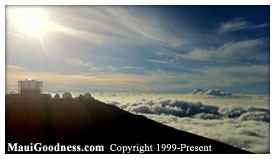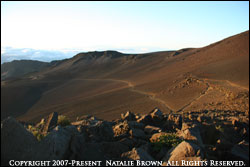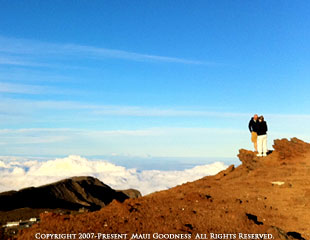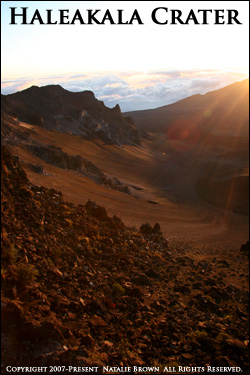 Summit Area
Summit Area
The summit of Haleakala is an island atop a volcanic island, with its own distinctive climate and habitats. Its cinder desert is sometimes frozen and seemingly barren, Yet a variety of creatures and unique plants like the ‘ahinahina (Silversword) have adapted to the summit’s extremes.
Despite the contrasts to seashores of Maui, the summit is connected to the rest of the island in critical ways. The upper slopes capture moisture to nourish the rain forest of Kipahulu and feed the streams and waterfalls in the valleys. The summit also preserves portions of the original Hawai’i, including native vegetation and evidence of the early inhabitants.
THINGS TO DO at Haleakala National Park:
 Trails – Explore the cinder desert on Keonehe’ehe’e (Sliding Sands Trail) and native subalpine shrubland on Halemau’u Trail.
Trails – Explore the cinder desert on Keonehe’ehe’e (Sliding Sands Trail) and native subalpine shrubland on Halemau’u Trail.- Scenic Overlooks – Enjoy vistas of volcanic features and island panoramas.
- Naturalist Programs – Inquire at either of the visitor centers.
- Bird Watching – Hosmer Grove Nature Trail and Halemau’u Trail offer excellent opportunities to bird watch.
- Picnics – Set up a picnic at either Hosmer Grove or the Headquarters Visitor Center.
- Camping – Hosmer Grove, available on a a first-come first served basis, is an wonderful spot to camp at especially since there are no permits required. In order to camp in the wilderness of Holua and Paliku, permits are required and available at the visitor center during operating hours.
- Bike the Volcano – You can do much of the above then be taken to the base of Haleakala National Park and ride all the way downhill to Haiku Town.
CAUTION:
- You are responsible for your own safety
- Be prepared for extreme and sudden weather changes. Dress in layers and bring rain gear.
- Be alert for symptoms of altitude sickness: headache, nausea, dizziness, shortness of breath. If you get altitude sickness, have help getting lower in altitude, drink lots of water, and call 911. If you’re near a park employee or the visitor center, ask them for assistance as well.
- Protect yourself from the sun. Cover up, use sunscreen, wear a hat and glasses. In cold weather, it’s easy to forget how powerful the sun is, especially at this altitude.
HALEAKALA PARK RULES:
- Respect the ‘aina (land). Many people consider the park lands to be sacred. Be mindful.
- Stay on designated trails. Off-trail hiking can kill unseen plants and animals or destroy cultural resources.
- Leave things as you find them, including rocks, which can possibly animal or plant homes.
- Help kep nene (Hawaiian Goose) wild. No feeding or approaching! Tame nene often get hit by cars.
- Limit group size to 12 or less.
- Enter on foot only, and don’t ride bicycles.
- No pets allowed on trail.
- Clean boots of dirt and seeds.
- Camp in designated areas only, and get a permit if required.
Now that you know what to do, and what not to do, you’ll have a better, safer, and less-impactful experience at the park. Maui thanks you!



